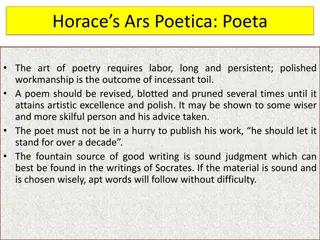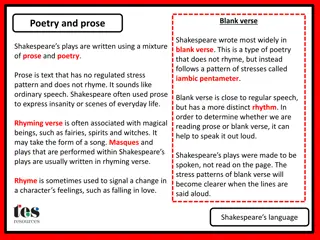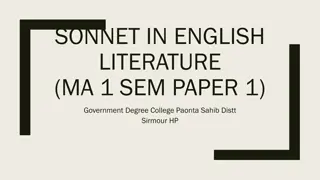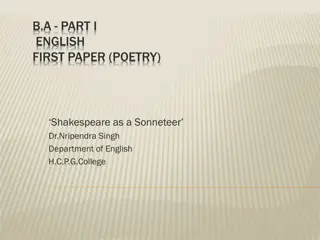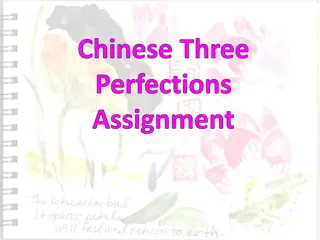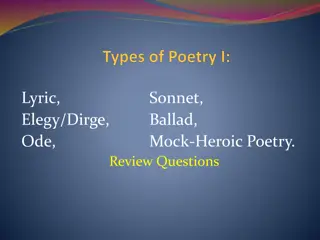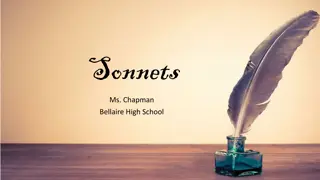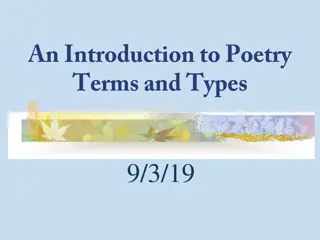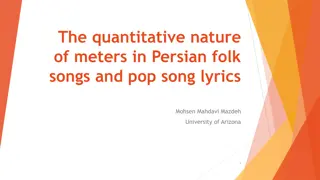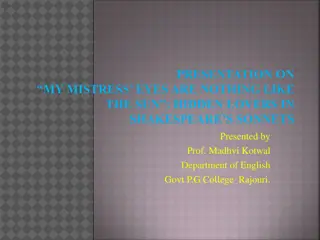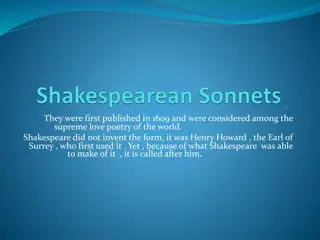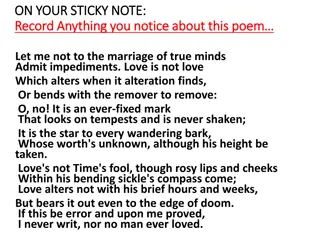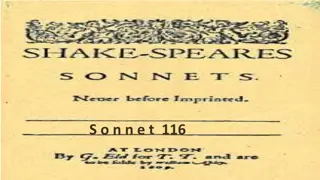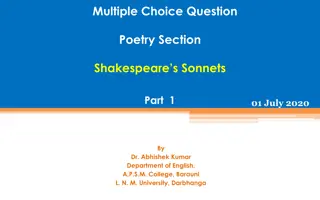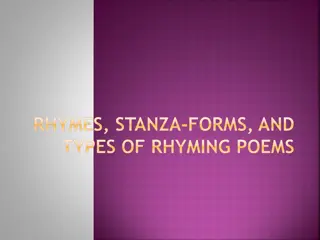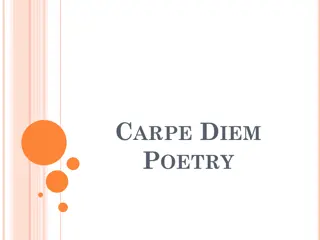Exploring the Art of Sonnets in Poetry
Delve into the world of sonnets with a focus on Petrarchan and English sonnet forms. Understand the structure, rhyme schemes, and themes these poetic forms offer through examples like Shakespeare's Sonnet 116. Discover the timeless appeal and influence of sonnets in Western literature.
Download Presentation

Please find below an Image/Link to download the presentation.
The content on the website is provided AS IS for your information and personal use only. It may not be sold, licensed, or shared on other websites without obtaining consent from the author. Download presentation by click this link. If you encounter any issues during the download, it is possible that the publisher has removed the file from their server.
E N D
Presentation Transcript
Part 2 Mastering poetry by Sara Thorne Textbook of the course of poetry for fist grade at college of Basic Education Lecturer: Assistant Professor Dr. Azhar Jasim Ali English Language Department College of Basic Education MustansiriyahUniversity Azharalzubeidi.edbs@uomustansiriyah.edu.iq
Poetic Form Form The Sonnet The Haiku Elegy Lyric Ode Pastoral Narrative Descriptive Villanelle
The Sonnet Sonnet, fixed verse form of Italian origin consisting of 14 lines that are typically five- foot iambics rhyming according to a prescribed scheme. The sonnet is unique among poetic forms in Western literature in that it has retained its appeal for major poets for five centuries. The form seems to have originated in the 13th century among the Sicilian school of court poets, who were influenced by the love poetry of Proven al troubadours. From there it spread to Tuscany, where it reached its highest expression in the 14th century in the poems of Petrarch. His Canzoniere a sequence of poems including 317 sonnets, addressed to his idealized beloved, Laura established and perfected the Petrarchan (or Italian) sonnet, which remains one of the two principal sonnet forms, as well as the one most widely used. The other major form is the English (or Shakespearean) sonnet.
The Sonnet The Petrarchan sonnet characteristically treats its theme in two parts. The first eight lines, the octave, state a problem, ask a question, or express an emotional tension. The last six lines, the sestet, resolve the problem, answer the question, or relieve the tension. The octave is rhymed abbaabba. The rhyme scheme of the sestet varies; it may be cdecde, cdccdc, or cdedce. The Petrarchan sonnet became a major influence on European poetry.
The Sonnet The English sonnet is composed of three quatrains, each having an independent rhyme scheme, and is ended with a rhymed couplet. The rhyme scheme of the English sonnet is abab cdcd efef gg. Its greater number of rhymes makes it a less demanding form than the Petrarchan sonnet, but this is offset by the difficulty presented by the couplet, which must summarize the impact of the preceding quatrains with the compressed force of a Greek epigram. An example is Shakespeare s Sonnet CXVI
Shakespeares Sonnet CXVI (Sonnet 116) Let me not to the marriage of true minds Admit impediments. Love is not love Which alters when it alteration finds, Or bends with the remover to remove: Oh, no! it is an ever-fix d mark, That looks on tempests and is never shaken; It is the star to every wandering bark, Whose worth s unknown, although his height be taken. Love s not Time s fool, though rosy lips and cheeks Within his bending sickle s compass come; Love alters not with his brief hours and weeks, But bears it out even to the edge of doom. If this be error and upon me proved, I never writ, nor no man ever loved.
Poetic Form Haiku, unrhymed poetic form consisting of 17 syllables arranged in three lines of 5, 7, and 5 syllables respectively. The haiku first emerged in Japanese literature during the 17th century, as a terse reaction to elaborate poetic traditions, though it did not become known by the name haiku until the 19th century. Ezra Pound, Robert Frost, and W.B. Yeats The flashing leaves dance The omnipresent wind blows A storm is brewing
Poetic Form Elegy, meditative lyric poem lamenting the death of a public personage or of a friend or loved one; by extension, any reflective lyric on the broader theme of human mortality. In classical literature an elegy was simply any poem written in the elegiac metre (alternating lines of dactylic hexameter and pentameter) and was not restricted as to subject. Though some classical elegies were laments, many others were love poems. Edmond Spencer Weep no more, woeful shepherds, weep no more, For Lycidas, your sorrow, is not dead, Sunk though he be beneath the wat'ry floor; So sinks the day-star in the ocean bed, And yet anon repairs his drooping head, And tricks his beams, and with new spangled ore Flames in the forehead of the morning sky: So Lycidas sunk low, but mounted high...
Poetic Form Lyric, a verse or poem that is, or supposedly is, susceptible of being sung to the accompaniment of a musical instrument (in ancient times, usually a lyre) or that expresses intense personal emotion in a manner suggestive of a song. Lyric poetry expresses the thoughts and feelings of the poet and is sometimes contrasted with narrative poetry and verse drama, which relate events in the form of a story. Elegies, odes, and sonnets are all important kinds of lyric poetry. Sr. Thomas Wyat, Henry Haward, and "Time will say nothing but I told you so, Time only knows the price we have to pay; If I could tell you I would let you know. If we should weep when clowns put on their show, If we should stumble when musicians play, Time will say nothing but I told you so. There are no fortunes to be told, although, Because I love you more than I can say, If I could tell you I would let you know."
Poetic Form Ode, ceremonious poem on an occasion of public or private dignity in which personal emotion and general meditation are united. The Greek word d , which has been accepted in most modern European languages, meant a choric song, usually accompanied by a dance. Alcman (7th century BC) originated the strophic arrangement of the ode, which is a rhythmic system composed of two or more lines repeated as a unit. In Latin the word was not used until about the time of Horace, in the 1st century BC. His carmina ( songs ), written in stanzas of two or four lines of polished Greek metres, are now universally called odes William Collins, Thomas Gray
Poetic Form /Ode Oh! mischievous usurper of my peace; Oh! soft intruder on my solitude, Charming disturber of my ease, That hast my nobler fate pursued, And all the glories of my life subdued.





